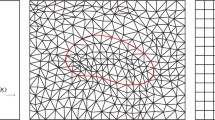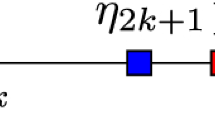Abstract
A second order difference method is developed for the nonlinear moving interface problem of the form
, where α (t) is the moving interface. The coefficient β(x,t) and the source term f(x,t) can be discontinuous across α (t) and moreover, f(x,t) may have a delta or/and delta-prime function singularity there. As a result, although the equation is parabolic, the solution u and its derivatives may be discontinuous across α (t). Two typical interface conditions are considered. One condition occurs in Stefan-like problems in which the solution is known on the interface. A new stable interpolation strategy is proposed. The other type occurs in a one-dimensional model of Peskin’s immersed boundary method in which only jump conditions are given across the interface. The Crank-Nicolson difference scheme with modifications near the interface is used to solve for the solution u(x,t) and the interface α (t) simultaneously. Several numerical examples, including models of ice-melting and glaciation, are presented. Second order accuracy on uniform grids is confirmed both for the solution and the position of the interface.
Similar content being viewed by others
References
R. Almgren, Variational algorithms and pattern formulation in dendritic solidification, J. Comput. Phys. 106 (1993) 337–354.
R. P. Beyer, A computational model of the cochlea using the immersed boundary method, J. Comput. Phys. 98 (1992) 145–162.
R. P. Beyer and R. J. LeVeque, Analysis of a one-dimensional model for the immersed boundary method, SIAM J. Numer. Anal. 29 (1992) 332–364.
J. M. Chadam and H. Rasmussen, eds., Free Boundary Problems in Fluid Flow with Applications (Priman Advanced Publishing Program, 1993).
S. Chen, B. Merriman, S. Osher and P. Smereka, A simple level set method for solving Stefan problems, UCLA CAM Report 96–21 (1996).
J. Crank, Free and Moving Boundary Problems (Oxford University Press, 1984).
L. Fauci and C. S. Peskin, A computational model of aquatic animal locomotion, J. Comput. Phys. 77 (1988) 85–108.
B. A. Finlayson, Numerical Methods for Problems with Moving Fronts (Ravenna Park Publishing, 1992).
A. L. Fogelson, A mathematical model and numerical method for studying platelet adhesion and aggregation during blood clotting, J. Comput. Phys. 56 (1984) 111–134.
B. Fornberg and R. Meyer-Spasche, A finite difference procedure for a class of free boundary problems, J. Comput. Phys. 102 (1992) 72–77.
R. M. Furzeland, A comparative study of numerical methods for moving boundary problems, J. Inst. Maths. Applics. 26 (1980) 411–429.
J. T. Heine and D. F. McTigue, A cold-based Laurentide ice sheet during the early to middle Wisconsin glaciation based on a transient thermal model, EOS, Transactions of the American Geophysical Union (November 1994).
K. Hutter, A. Zryd and H. Röthlisberger, On the numerical solution of Stefan problems in temperature ice, J. Glaciology 36(122) (1990).
J. B. Keller, Melting and freezing at constant speed, Phys. Fluids 39(6) 1986.
R. J. LeVeque and Z. Li, The immersed interface method for elliptic equations with discontinuous coefficients and singular sources, SIAM J. Numer. Anal. 31 (1994) 1019–1014.
R. J. LeVeque and Z. Li, Immersed interface methods for Stokes flow with elastic boundaries or surface tension, SIAM J. Sci. Comput., to appear.
Z. Li, The immersed interface method - a numerical approach for partial differential equations with interfaces, Ph. D. Thesis, University of Washington (1994).
Z. Li and A. Mayo, ADI methods for heat equations with discontinuities along an arbitrary interface, Proc. Sympos. Appl. Math. 48 (1994) 311–315.
Z. Li, A note on immersed interface method for three dimensional elliptic equations, Comput. Math. Appl., to appear.
R. H. Nochetto, M. Paolini and C. Verdi, An adaptive finite element method for two-phase Stefan problems in two space dimensions, SIAM J. Sci. Statist. Comput. 12 (5) (1991) 1207–1244.
S. Osher and J.A. Sethian, Fronts propagating with curvature-dependent speed: Algorithms based on Hamilton-Jacobi formulations, J. Comput. Phys. 79 (1988) 12–49.
C. S. Peskin, Numerical analysis of blood flow in the heart, J. Comput. Phys. 25 (1977) 220–252.
C. S. Peskin, Lectures on mathematical aspects of physiology, Lectures Appl. Math. 19 (1981) 69–107.
M. E. Rose, An enthalpy scheme for Stefan problem in several dimensions, Appl. Numer. Math. 12 (1993) 229–238.
D. Sulsky and J. Brackbill, A numerical method for suspension flow, J. Comput. Phys. 96 (1991) 339–368.
A. Wiegmann and K. Bube, Immersed interface method for 1D non-linear differential equations with discontinuous coefficients and singular sources, Preprint (1995).
L. C. Wrobel and C. A. Brebbla, eds., Computational Modeling of Free and Moving Boundary Problems II (Computational Mechanics Publications, 1993).
Author information
Authors and Affiliations
Rights and permissions
About this article
Cite this article
Li, Z. Immersed interface methods for moving interface problems. Numerical Algorithms 14, 269–293 (1997). https://doi.org/10.1023/A:1019173215885
Issue Date:
DOI: https://doi.org/10.1023/A:1019173215885




